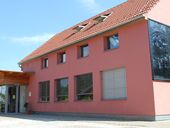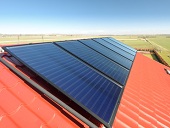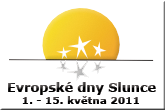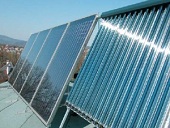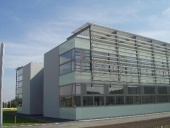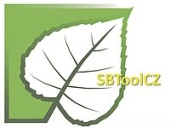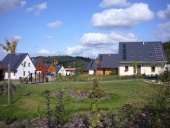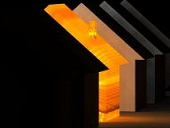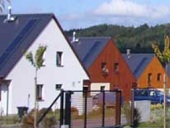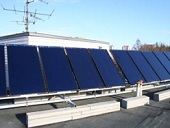Much has been written about this Moravian Village at the foot of the White Carpathian Mountains. It is renown for its environmental projects, it has been visited by many prominent personalities and it is considered an example of energy saving and environmental construction. This time, we have focused on a passive house that works as a model of environmental projects in rural areas.
Archiv článků od 1.11.2010 do 27.6.2011
Our serial continues with this low-energy house built with sand-lime bricks. This time, the family house is located not far from Liberec, in the foothills of the Jizera mountains. The surroundings, predominantly rural houses near a protected natural area, influenced the shape of the house. Its location responds primarily to the surrounding buildings and the slightly sloping land.
The European Solar Days successfully promote the use of a free unlimited renewable energy source available everywhere to everyone to generate electricity as well as heating and cooling: the SUN.
This campaign raises public awareness and involves several hundred thousand citizens at local level. Pioneer countries such as Austria, Germany, Switzerland, as well as others that successfully embraced this initiative like France, Italy and Spain, are only too keen to share their experience and help spread the word. The European Solar Days are celebrated in an increasing number of countries and in 2010 around 6.600 events were planned in 17 European countries by diverse organisations ranging from solar equipment manufacturers to schools and local authorities.
European and national policy and trends promoting the development and use of renewable energy recently caused a boom for solar systems for DHW and heating in family houses in this country. Whether it makes sense, what are the problems for such systems since we can expect and how to optimize these systems, this post.
Coloured photovoltaic cells are occasionally used in architectural applications. Their wider utilisation is currently limited by the lower efficiency compared to cells with an optimal anti-reflective coating. Research is focused on desing and manufacturing of anti-reflective coating, which besides of required color will have minimised the reflection in the infrared.
Over 5000 buildings in Austria have been constructed in the passive standard. In the future, a considerable part of new constructions should be build in the passive standard. The goal is to have all subsidised residential buildings built in the passive standard by 2015. The aim of the study was to learn from the first residential complexes of passive buildings. The main questions were: Do the passive buildings meet the ambitious expetations of the project? How satisfied are the people living in them? What additional construction costs can be expected and what are the actual energy savings compared to conventional residential complexes?
As in other countries, in Norway energy remediation is carried out mostly on an average level. For a decade, this has blocked highly effective energy saving measures in public housing because better energy remediation measures pay off only after a long time. Myhrerenga is the first block of flats in Norway renovated according a passive house concept.
Czech method for building quality classification SBToolCZ and the first certificated building X-LOFT
One of the way how to recognize quality of buildings are methods for sustainable buildings classification. SBToolCZ is a certification method for complex building quality classification according to sustainable buildings principles – including environmental, social and economic criterions. The SBToolCZ method is based on the international SBTool system. Criterions and requirements are being modified according to standards development on the international level. SBToolCZ was developed on Faculty of civil engineering (Czech Technical University Prague), CIDEAS centre.
Subsidy programs to promote the reduction of energy consumption and to increase the use of renewable energy sources are available not only in the Czech Republic but also in our neighbouring countries. Let's have a look at the possibilities of financial support are available in Germany field of energy efficiency and renewable energy sources.
Low energy (LEB) and passive buildings (PB) are becoming standard for new constructions in EU countries. They aren't experiments anymore, but absolutely ordinary mass production of sophisticated residential buildings. Only in Germany, Austria and Switzerland there are already thousands of buildings that meet the passive standard and their number doubles every year. The cost of passive buildings is only 5-7 % higher than those of conventional ones, and yet, their consumption of energy and heating is up to 90 % lower!
Author raises discussion and proposed changes in the rules of the energy audit. Draws attention to the criteria for evaluating alternatives and to small requirements for variability solutions. Read controversy of the author and reviewer who considers the methodology as sufficient and sees a problem in processing audits.
The group of twelve residential passive houses and school facilities in Koberovy can be characterised as the first mass project of experimental construction based on energy efficient wooden structures carried out in the Czech Republic. The construction is located on a plot of land oriented to the South. The concept respects the regulations for the protected area Czech Paradise within urban communities, which require saddle roof, entrance through the longer part of the façade, limited glazing areas, among others. The concept does not result in a monotonous terraced construction. The new housing estate is logically related to the current character of the surrounding buildings in the village.
Protection against lightning is something other than a lightning conductor. Lightning conductor is for capturing a flash, for safely the grounding system. It is for the prevent injury of people and protection against fire house. If it is all what we will do, we can say goodbye to all the electronics.
The directive 2010/31/EU on the Energy Performance of Buildings – called EPB, EPBD II or EPBD Recast – was passed last May. EU member countries are obliged to implement these new requirements into their national legislations. The implementation of 2010/31/EU was addressed by a number of seminars during the recent Aqua-therm 2010 trade fair. The following article presents you with the most important facts from the presentations and with links to information that was published before and during Aqua-Therm 2010.
National Renewable Energy Action Plan of the Czech Republic (NREAP), which was 25 August 2010 approved by the Czech government is not sufficiently fulfilling the requirements of Directive 2009/28/EC. A combination of the NREAP and the draft of the large amendment of the Act. No. 180/2005 Coll. on promotion of renewable energy sources can paradoxically lead to a downturn of the renewable energy sector.
Designing solar systems so they will produce the the most heat during the year or electricity at the lowest cost is quite a complex matter. A number of factors should be considered when calculating the solar systems, especially the intensity of the solar radiation in individual locations throughout the year. Without a simulation software that can work with this variable data, the calculation can only be very approximate. If we want to get more accurate results and fast, using sofware is esential.
zpět na aktuální články
